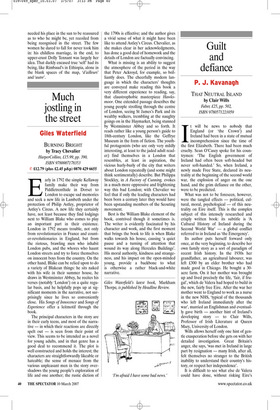Much jostling in the street
Giles Waterfield
BURNING BRIGHT by Tracy Chevalier HarperCollins, £15.99, pp. 390, ISBN 9780007178353 ✆ £12.79 (plus £2.45 p&p) 0870 429 6655 Early in 1792 the simple Kellaway family make their way from Piddletrenthide in Dorset to London to escape sad memories and seek a new life in Lambeth under the protection of Philip Astley, proprietor of Astley’s Circus. A new life they certainly have, not least because they find lodgings next to William Blake who comes to play an important part in their existence. London in 1792 means trouble, not only from revolutionaries in France and counter-revolutionaries in England, but from the riotous, brawling men who inhabit London pubs, and the whores who haunt London streets and try to force themselves on innocent boys from the country. On the other hand, Blake can be relied upon to do a variety of Blakean things: he sits naked with his wife in their summer house, he draws in Westminster Abbey, he recites his verses (notably ‘London’) on a quite regular basis, and he helpfully pops up at significant moments in the narrative, not surprisingly since he lives so conveniently close. His Songs of Innocence and Songs of Experience offer a leitmotif through the book.
The principal characters in the story are in their early teens, and most of the narrative — in which their reactions are directly spelt out — is seen from their point of view. This seems to be intended as a novel for young adults, and in that genre has a good deal to recommend it. The plot is well constructed and holds the interest; the characters are straightforwardly likeable or hateable; the sense of menace from the various unpleasant men in the story overshadows the young people’s exploration of life and one another; the rustic diction of the 1790s is effective; and the author gives a vivid sense of what it might have been like to attend Astley’s Circus. Chevalier, as she makes clear in her acknowledgments, has done a good deal of homework and the details of London are factually convincing.
What is missing is an ability to suggest the atmosphere of the period in the way that Peter Ackroyd, for example, so brilliantly does. The cheerfully modern language in which the characters’ thoughts are conveyed make reading this book a very different experience to reading, say, that claustrophobic masterpiece Hawksmoor. One extended passage describes the young people strolling through the centre of London, seeing St James’s Park and its wealthy walkers, trembling at the naughty goings on in the Haymarket, being stunned by Westminster Abbey and so forth. It reads rather like a young person’s guide to 18th-century London, like the Geffrye Museum in the form of fiction. The youthful protagonists (who are only very mildly interesting, at least to the jaded adult reader) find themselves in a London that resembles, at least in aspiration, the vicious hurly-burly of the city that writers about London repeatedly (and some might think sentimentally) describe. But Philippa Stockley, in A Factory of Cunning, evokes in a much more oppressive and frightening way this bad London; with Chevalier we feel that if only the leading characters had been born a century later they would have been upstanding members of the Scouting movement.
Best is the William Blake element of the book, contrived though it sometimes is. The writer is evidently fascinated by his character and work, and the first moment that brings the book to life is when Blake walks towards his house, causing ‘a quiet pause and a turning of attention that wound its way along Hercules Buildings’. His moral authority, kindness and strangeness, and his impact on the open-minded young, provide a backbone to what is otherwise a rather black-and-white narrative.
Giles Waterfield’s latest book, Markham Thorpe, is published by Headline Review.


























































































 Previous page
Previous page